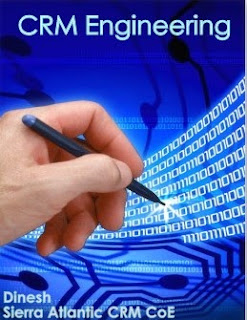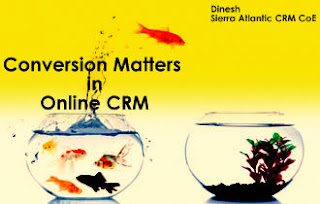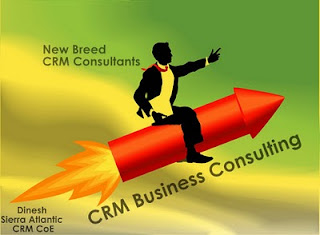Dears,
Different positions within a sales force require different functions from an CRM system, and tailoring to fit those functions is a big part of successful CRM strategies.
Corporate professionals can learn a lesson from George S. Patton, the flamboyant WWII general.
"I don't expect my men to understand anything more than what's right in front of them, the tactical situation," Patton said. "As general, it's my job to understand the big picture." This speaks volumes when considering how the rank and file and various corporate leaders should carry out their CRM or sales force automation (CRM ) marching orders.
In sales, as in any department, when you move up the corporate ladder job roles go from tactical to strategic, so an CRM solution that serves every member of the sales hierarchy needs to address these various responsibilities. For simplicity's sake, let's divide sales forces into three segments: salespeople, management, and the executives. Each segment has unique requirements and functionality necessary to help customize its view of the sales department. What follows are examples of how CRM is used throughout the sales organization.
In the Trenches
Account executives are the revenue generators, and when faced with an opportunity to close a deal, they can't stumble. However, with all the hoops they have to jump through, it's a wonder when they don't. Inside CRM and CRM systems, salespeople spend most of their time punching in customer data and tracking deals. A handsome amount of time is also spent responding to customer questions and preparing customer quotes. It is irksome, then, that the systems intended to help facilitate these efforts often hinder operations, forcing salespeople to wade their way through much complexity. Part of the problem is that salespeople are forced to do too much administrative work.
That's why account executives need tools to respond to customer inquiries faster and more effectively than previous methods. To do this they'll need the ability to easily record, track, and change customer and product information. Plus, they'll need easy access to updated testimonials, sales programs, and competitive data. Naturally, the less complicated the system, the more productive employees will be. When the complexity is removed, salespeople will consider it a tool, not a hindrance, and will update it regularly, which helps managers who rely on this information to make smarter decisions.
Account executives also spend a good portion of their day communicating with management. Besides reporting results for the day, week, month, many companies have processes that require managerial approval for discounts, quicker delivery, or customers with bad credit ratings. Therefore, any system functionality that improves communication between a sales rep and her manager, such as alerts and messaging capabilities, is vital to this process.
Last, any account executive will spend at least a few minutes of company time tracking her commission. For salespeople, there isn't a bigger motivator. Salespeople "are coin operated. & Anything that keeps them updated on their ability to make money is a huge motivator."
Looking ahead, the emergence of handheld mobile devices and wireless technology has been and will continue to be the biggest technological development for the account executive. Depending on the industry, salespeople could spend most of their time on the road, and with 2010 promising to be a big year for wireless connectivity, future developments could have a big impact on how sales executives do their jobs. With the arrival of 3G networks, VoIP, and dual-mode handsets, account executives will have the ability to access and download large volumes of data from an CRM system and interact with other back office systems, transforming their handhelds and PDAs from simple email receivers to mobile computers.
Aside from mobility, some companies are strengthening the bonds between sales and marketing. For account executives this means acquiring basic information about customers who have been deemed hot by the marketing department. Any customer contact info, interaction, or purchasing history--and any marketing information like response rates--helps provide account reps with information to turn a prospect into a lead. The integration of sales and marketing has the potential to affect the account executive the most.Instead of entering information many times over, you're leveraging information already acquired by marketing, but companies are still trying to connect the dots and there is still of lot of work to be done with this business process."
CRM for Sales Management
Sales management falls somewhere in the middle of the corporate ladder, whether it's a branch manager in charge of three to four account executives or a regional manager. CRM for sales management must combine the best of both the executive's and the account representative's world. They do so by integrating multitudes of sales, market, and pipeline reports into customizable dashboards. This has enabled managers to gain an unprecedented view of their sales force. The result is, they can manage and allocate resources quickly and more efficiently than ever before. "Sales managers are involved in the deal making. "Their mindset is, What can we do today so we make our goals for the week, month, or quarter? At the same time, they need to step back and focus on the big picture, which for them is their department or region, and allocate their resources accordingly."
CRM solutions should help management measure and manage the effectiveness of internal processes. This means managers spend a good portion of their time studying dashboards that identify sales opportunities, deal stages, and close rates daily, weekly, monthly, or quarterly. These performance metrics can also be evaluated by individual, group, or region. Additionally, as companies get more adept at bringing together customer information from various areas, including sales, customer service, accounting, and the supply chain, the job of a sales manager will become more comprehensive. Depending on the industry, deals may require involvement from multiple departments inside a company, such as manufacturing, research and development, or accounting.
By gaining better visibility into other departments, a sales manager will become more of a facilitator, removing internal bottlenecks that crop up or quickly notifying all stakeholders when a change is introduced. "Now the [manager] is utilizing the CRM solution as a tool, as opposed to just a reporting function. "They want a tool that improves their ability to sell, not just something that provides reporting functionality. That's farther up the chain."
Many managers, particularly regional managers, take a more strategic approach, spending their day going over pipeline dashboards and reports to review which pipelines and markets are generating the most money. "Sales managers will be picking out the largest opportunities, the two or three out of 12 that are going to land the big bucks. "They're going to be looking at which accounts are generating the most revenue, where are the biggest pipelines, and which pipelines are growing the fastest."
Managers are also benefiting from coaching tools. In the past, CRM focused primarily on providing management with a reporting tool. Today, many vendors are embedding new, sophisticated ways to conduct account planning. New sales systems place action items around the most important accounts, such as which business processes or steps should be followed, which sales rep should conduct them, and in what time frame. By understanding where the account executives are in the sales cycle and where they are going, management can offer advice or tips to help facilitate selling success. "This promotes more of a coaching and supporting relationship between a manager and his or her sales representatives versus the typical 'I'm just looking at what you've done and if you didn't make your numbers I'll beat you for it.
The Command Center: CRM for Executives
Any good CEO or vice president of sales continually understands his company's position within the market. While sales management is focused on its own piece of the pie, C-level executives maintain a holistic view of both the sales organization and the company. They're responsible for the investments and distribution of resources and assets throughout the entire sales organization. Their responsibility is reflected in their mindset. A salesperson or sales manager thinks day to day, month to month, or perhaps quarter to quarter, but the mindset of a CEO or vice president of sales is that of quarterly, yearly, and beyond. Still, a CEO or vice president of sales should never lose sight of the tactical picture. "If you're a vice president of sales and you've gotten away from the clients, the deals, and the processes, you've probably gone way too far to the other side of what you should be doing in the sales environment," .
So how does a CEO or vice president of sales allocate his time to accomplish these goals? He spends most of the day reviewing, preparing, and presenting reports. He will review dashboards that highlight pipeline growth and forecast models, product trends (which can include cross references by geographies, regions, industry verticals, or markets), and win/loss ratios for certain divisions within the sales organization. This should enable him to determine if success or failure is from best practices at the sales force level or from strategies based at the executive/management level. Last, with such a high priority on forward-looking visibility, a vice president of sales will spend a significant amount of time running predictive forecasts. "An executive wants to know where the company is and where it's going," .. "Tactically, they still need the important numbers so they can run the business, but in general they're looking for trending information that enables them to better understand the market their company services to better determine where they should make large, long-term investments in the sales department."
Another executive responsibility is ensuring that good business practices and processes are being implemented and followed. Many times, this responsibility can be overlooked. Consequently, an CRM system should have strong drill-down capabilities so executives can take a detailed look at any segment of the sales team and its ability to enter new sales plans, market strategy, or business processes as feedback. Executives need to "take a more outward focus," .A sales executive needs a tool that will transcend throughout the organization so the organization flies in formation with his strategy. If he can do that, that's really a home run for the CEO."
Looking Ahead
As vendors continue to expand the capabilities their CRM solutions offer, members of a sales force will be hard pressed not to accomplish more in a single day than their predecessors. Advancements in wireless connectivity will bring mobility to the account executive, account planning and robust reporting tools will enable managers to gain insight into and coach their salespeople like nothing previously seen, and the ongoing development of business process and technology to integrate CRM with marketing and customer service will enable sales executives to equip their organization with a 360-degree view of the customer. Providing each level of the sales force with an application that enhances its ability to accomplish that quickly and more efficiently than before, and to communicate that information up and down the corporate ladder effectively, helps any sales department's ability to deliver profitable results to both the customer and the company. It's exciting to see how sales technology is adapting the roles of salespeople. "You have telecom infrastructures now offering full, wireless connectivity, vendors releasing new reporting tools. It's challenging the way salespeople conduct business, and forcing them to respond to customers quicker and more efficiently than before."
Sales Tools by Job Role
CEO
• Sales Forecast Accuracy
• Forward Looking Visibility
• Improved Market Share
Vice President of Sales
• Sales Forecast Accuracy
• Methods to Accelerate Opportunity Development/Share Best Practices
• Improve Revenue per Sales Representative
• Improve Win/Loss Ratio
• Effectively Capture Loss Data for Strategic Planning/Pricing
• Improve Consistency Across the Sales Organization
• More Effectively Identify New Market Opportunities
• Capitalize on Cross- and Upsell Opportunities
Sales Management
• Sales Forecast Accuracy
• Ability to Focus on Big Impact Opportunities
• More Effective Coaching and Mentoring
• Better Monitoring of Sales Performance
• More Effective Evaluation of the Quality of an Opportunity
• Monitor Account Activities Relative to Results (Call Reports)
Account Executive
• Access to Customer Data
• Improved Quote and Proposal Capabilities
• Faster and More Flexible Corporate Approval Capabilities
• Integrated Access to Relevant Information
• What-if Simulation Tools
• Higher Quality Leads from Marketing
Good Luck
Your P&C
DC*












